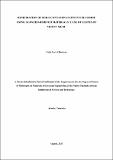| dc.description.abstract | While exposure to low fluoride is essential for stronger bones and teeth, exposure to high
concentration (> 3 mg/L/day) leads to hyperostosis and osteoporosis. This research evaluated
the role of fertilizer application on soil’s fluoride release, and assess the effectiveness of using
seaweed (Eucheuma cottonnii) derived materials for remedial purposes. The soil
characterization results in the study area, indicated the availability of diverse fluoride fractions
and in different quantities in the soil such that; water-soluble (Ws-F) (39.5 ± 0.5 mg/kg),
Exchangeable (Ex-F) (3.5 ± 0.5 mg/kg), bound to iron/manganese (Fe/Mn-F) (3.1 ± 1.0 mg/kg),
and organic matter bound (Or-F) (9.1 ± 2.1 mg/kg) fluoride whereas the total fluoride (Tot-F)
was 422 ± 52.9 mg/kg. The study further reports that the use of three studied fertilizers
(diammonium phosphate (DAP), Urea, and farmyard manure) accelerates the bioavailability of
fluoride in the soil by increasing Ws-F. These results deliver alerts to the plant health regulators
suggesting proper management of the quality of fertilizers used for the enhancement of crop
quality particularly those used in fluoride-contaminated agricultural soils. While fertilizer
application accelerated the bioavailability of fluoride in the soil, soil amendment with dried
seaweed (DSW) led to a decrement of Ws-F from 81.7 ± 3.1 mg/kg up to 28.5 mg/kg whereas
the fermented seaweed (FSW) decreased Ws-F from 81.7 ± 3.1 mg/kg to 12 ± 1.3 mg/kg
following 5 % (w/w) amendments. But unlike DSW and FSW, seaweed-derived biochar (SB)
adsorbed fluoride at specific pH five (5) from 103.1 mg/kg to 91.2 ± 3.2 mg/kg whereas
hydroxyapatite activated seaweed-biochar (HSB) exhibited defluoridation capabilities at varies
pH (3 – 11) with a maximum Ws-F reduction from 103.1 mg/kg to 21.6 ± 2.1 mg/kg which is
close to the recommended limit of 16.4 mg/kg. The DSW and FSW defluoridation was based
on complexation reactions, alteration of soil properties, and increasing the soil-specific surface
area, but SB and HSB defluoridation was through chemisorption. Therefore, seaweed-derived
materials are capable of remediation of fluoride contaminated soils and the study recommends
further investigation on fluoride uptake by crops in pot and field experiments post-amendment
with seaweed derived materials. | en_US |

